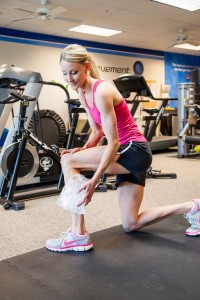Preventing and Healing from Sports/Exercise Injuries

Injuries. If you’re an avid exerciser, having to put your exercise routine on hold because of an injury can be almost as painful as the injury itself. As a long-distance runner, I’ve had my share of injuries. Though you can’t completely avoid becoming injured at some point, here are some strategies to reduce your chances of injury:
- Don’t add too much too fast. A common cause of injury is increasing your exercise frequency or intensity too quickly. So, take a gradual approach. For example, rather than increasing your workout from 30 minutes to 60 minutes per day, try adding only 5–10 minutes per day. After a few weeks, add 5–10 more minutes to your daily workout.
-
Following your workout, ice the primary muscles you used. Icing can reduce swelling, tissue breakdown, and muscle soreness.

Stretch your muscles at the end of each workout.
- Stretch and roll. At the end of each workout, stretch your muscles and use a foam or stick roller to work on any tight or tender muscles.
- Cross-train. When you alternate types of exercise, you give your muscles time to recover, you reduce the potential for overtraining, and you are less likely to develop muscle imbalances. If you decide to focus on only one type of exercise, alternate hard and easy workouts.
- Take a day of rest. Set aside one day of the week to rest, which will help you recover physically (and mentally).
- Know how much pain is too much. This is a hard one, but over the years as I’ve listened to my body, I’ve developed a better sense of what pain I can exercise through and what pain is a signal that I need to scale back or even take a few days of rest. If slight discomfort is turning into continual pain, take a break for a couple days. Taking off a few days now may prevent an injury that would require you to take off several weeks.
-
Eat an exercise-friendly diet.
- Carbs are the main source of fuel in sustained activity, so fill up on whole grains, fruits, vegetables, and other unrefined carbs.
- You also need to consume lean protein to help rebuild muscle tissue you damaged during exercise. Good sources of lean protein are legumes, lean meat, and low-fat dairy.
Try Blendtec's Strawberry Ginger Refresher for a delicious, healing drink.
-
- To reduce inflammation, eat fruits and vegetables (rich in antioxidants) and fish or fish oil (or other foods rich in omega-3 fatty acids). Research also shows that eating just ¼ teaspoon ginger prior to exercise can reduce postworkout soreness and inflammation. Try the Strawberry-Ginger Refresher for a delicious mix of fruit and ginger that can help your body recover from workouts.
- Make sure to drink enough water! It's amazing how many problems proper hydration can solve.
- Get enough sleep. Many pro athletes sleep more than 8 hours a night—and then take a nap during the day—because they know how much sleep affects their performance. I know that 10 hours of sleep is wishful thinking for my crazy-busy life, but I also know how much better my workout goes when I get 8 hours of sleep compared to 6.5 hours of sleep. Sufficient shut-eye not only increases energy but is also a prime time for muscle repair.
 Ice your injuries
Ice your injuries
Follow the guidelines above to help prevent injuries. But what if you still get injured? Luckily, I also have some tips for speeding up the healing process:
- Rest, ice, compress, and elevate (RICE). RICE is the standard injury advice because it works.
- Add heat. Two days following the onset of the injury, alternate between icing and heating the injured area to decrease swelling and promote blood flow.
- Continue to eat a healthy diet. Focus on eating lean protein, vitamin-packed fruits and vegetables, foods with omega-3 fatty acids, ginger, garlic, and turmeric.
- Be patient. I have a hard time applying this tip, but I’ve learned the importance of patience. If you try to get back into exercising before you’ve healed, you may just reinjure yourself—potentially more seriously. You might find that you aren’t ready to get back to your favorite form of exercising but can do some cross-training. However, if you feel pain (particularly increasing pain) in the injured area, scale back and give yourself more time to heal. In the long-run, you'll be happy you did.
Resources
Berardi, John M., and Ryan Andrews. “Eating for Injury Recovery.” Accessed April 9, 2013. Dartmouth-Hitchcock. “Ten Tips to Prevent Running Injuries.” Accessed April 9, 2013. Clark, Nancy. “Foods to Speed Recovery from Injury.” Accessed April 9, 2013. Fitzgerald, Matt. “3 Ways to Prevent Running Injuries.” Accessed April 9, 2013. Kuang, Cliff. “Infographic of the Day: Why Pro Athletes Sleep 12 Hours a Day.” Accessed April 9, 2013.




 Ice your injuries
Ice your injuries
Excellent article. I think it’s a very good experience. It is a great solution for Preventing and Healing from Sports/Exercise Injuries. And I believe it can be beneficial for many. So I liked your information. it’s very interesting and very helpful for me and others. Include more article about this topic. Thank you for sharing
Have a nice day
Leave a comment